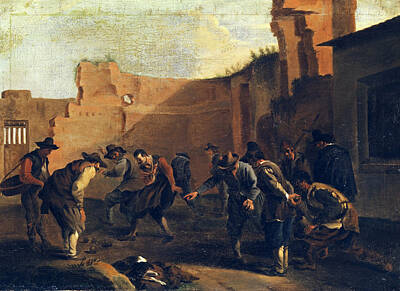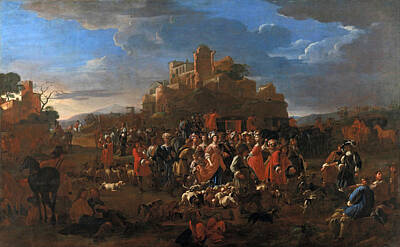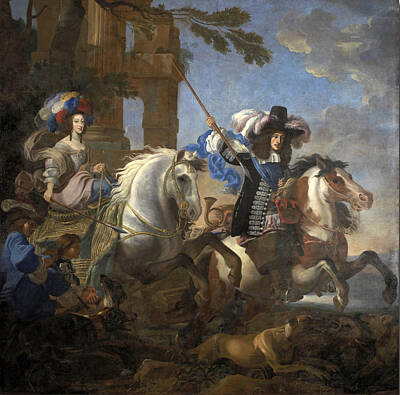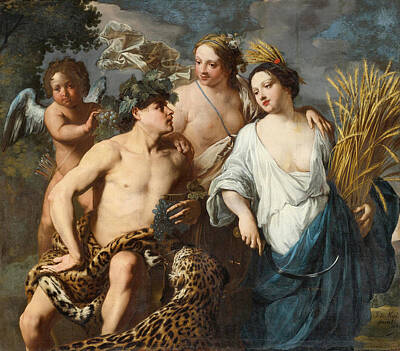Jan Miel
The Curea With Royal Court Carlo Emanuele II And Francesca D'orleans
Henriette Adelaide Of Savoy And Ferdinand Of Bavaria On Horseback
Jan Miel [1] (1599 in Beveren-Waas – 1663 in Turin) was a Flemish painter and engraver who was active in Italy. He initially formed part of the circle of Dutch and Flemish genre painters in Rome who are referred to as the 'Bamboccianti' and were known for their scenes depicting the lower classes in Rome. He later developed away from the Bamboccianti style and painted history subjects in a classicising style.
He collaborated with many artists in Rome and worked in the latter part of his career in Turin as the court painter of Charles Emanuel II, the Duke of Savoy.[2]
Life
Jan Miel was probably born in Beveren-Waas, but Antwerp and 's-Hertogenbosch have also been suggested as possible birthplaces. There is no information on his training but it is assumed that it took place in Antwerp.[3] The seventeenth century Italian biographer Giovanni Battista Passeri refers to a training by Anthony van Dyck in Flanders but there is no independent evidence for this statement.[4]
Boy playing a flute
Miel's stay in Rome in the period from 1636 to 1658 is documented, but it is possible that he was already there from 1633.[5] In Rome he became a member of the Bentvueghels, an association of mainly Dutch and Flemish artists working in Rome. It was customary for the Bentvueghels to adopt an appealing nickname, the so-called 'bent name'. For Miel two different bent names are documented: Bieco (which means squint in Italian) and Honingh-Bie (which means honey bee and is derived from the surname 'Miele' by which he was known in Italy and which means 'honey' in Italian).[3]
In Rome he also became linked to the circle of genre painters whose work was influenced by the Dutch genre painter Pieter van Laer and were referred to as 'Bamboccianti'. The Bamboccianti were mainly Dutch and Flemish artists working in Rome who mostly produced small cabinet paintings or prints of the everyday life of the lower classes in Rome and the surrounding countryside. Jan Miel was a vital force in the development of this new tradition in Rome.[5]
Miel became in 1648 the first northern artist to be admitted to the Accademia di San Luca, a prestigious association of leading artists in Rome. A stay of Miel in Northern Italy of around 1654 is documented. From 1658 until his death he resided in Turin, where he was appointed court painter of Charles Emanuel II, the Duke of Savoy.[2]
Work
General
Charlatan
Miel’s first dated paintings from the 1630s already show the influence of Pieter van Laer and the Bamboccianti in that they depict low-class subjects engaged in their normal business or at play. Popular subjects included morra players, gamblers, village dances, quacks, barbers, cobblers, itinerant musicians and actors, etc. Examples of his early work in this genre include The bowls players (Louvre) and The cobbler (Musée des Beaux-Arts et d'archéologie de Besançon), both produced in 1633. In this period he reworked and copied paintings by van Laer.[2]
An example of a work in this so-called 'bambocciate' style is the Charlatan (Hermitage Museum, 1650s). The composition depicts an itinerant medicine man with his assistants, who is demonstrating a potion to a credulous crowd. The high platform, upon which the main personages are placed, carries a sign reading VERO SECRET CONT... ('A true cure for...') The theme of charlatanism was common in 17th-century painting and appeared also in works by Adriaen Brouwer, Jan Steen and Karel Dujardin. The main personages in the Hermitage painting are shown with the disguise of characters of the commedia dell'arte. The charlatan wears the mask and costume of Il Dottore while the figure with the guitar wears the costume of a Zanni (madcap servant). The use of characters from the commedia dell'arte can also be found in other works by Jan Miel, including Carnival in Rome (Prado Museum, 1653) and The Actors' Rehearsal (Zingone collection, Rome).[6]
Carnival in the Piazza Colonna
During the 1640s and 1650s Miel began, just like Michelangelo Cerquozzi, to expand the scope of bambocciate paintings by paying less attention to the surrounding landscape and instead stressing the anecdotal aspects of city and country life. These works were repeatedly used as a model by the Bamboccianti in the second half of the century and by the genre painters working in Rome during the early 18th century.[2]
Miel's most original contribution to genre painting are his paintings of carnival scenes. An example is the Carnival in the Piazza Colonna (Wadsworth Atheneum, 1645). The painting gives a powerful depiction of the tension of carnival. As is common in Miel's 'bambocciate' compositions, noble and common people appear in the same scene: the statue of St. Paul atop a Greek column is surrounded by Roman nobility in lavish costumes and mounted on horseback while the common people are presented as the merrymakers: panhandlers, urchins and hawkers. A Commedia dell'Arte troupe is also present. In the painting, actors are masqueraded as figures from all strata of society. The feast is taking place on Shrove Tuesday, the last day of the carnival. Merrymaking has reached its peak and in the background winter hangs in effigy.[7]
Collaborations
Miel often collaborated with other artists as was the custom at the time. He painted the staffage for the vedute (cityscapes or other views) by Viviano Codazzi and Alessandro Salucci and the landscapes of Gaspard Dughet and Angeluccio.[2]
The Arch of Constantine, with Alessandro Salucci
Jan Miel worked particularly closely with Alessandro Salucci, an important innovator of veduta painting who produced many capricci, which often incorporated antique Roman monuments in imaginary environments. The collaboration between the two artists commenced in 1635 and ended when Miel left Rome for Turin in 1658 to work at the court of Charles Emmanuel II, Duke of Savoy. The only dated example of the two artists' collaborative efforts is an Imaginary Seaport (Cincinnati Art Museum), which is dated to 1656.[8] Miel excelled in depicting stories for which the large open spaces in Salucci's view paintings provided suitable settings. Miel often included multiple anecdotal scenes in a single work. This is evident in An architectural capriccio with an ionic portico, a fountain, a two story loggia, a Gothic palace and figures on a quay (Christie's, Sale 1708, Lot 56) where the elegant couple on the lower left on the stairs of the portico are acting separately from the figures at the well next to them, while the latter figures, in turn, are oblivious to the card players on the steps further back.[9] Miel's figures were typically farmers, beggars, morra players, innkeepers and porters often mixed with elegantly dressed men and women, who provided a rich flavor of Roman daily life to the architectural setting created by Salucci.[10]
Actors from the Commedia dell’Arte on a Wagon in a Town Square
There is evidence that in 1641, Jan Miel was documented in the studio of Andrea Sacchi. This collaboration is rather exceptional since Sacchi was an important critic of the Bambocciante style of which Miel was an important representative. This stay in Sacchi's studio may have been instrumental in the artist's evolutions towards the "gran maniera" of painting.[11] Miel worked with Andrea Sacchi on the painting Urban VIII visits the Church of the Gesù (Galleria Barberini, Rome, 1641).[12] It is believed that Sacchi only executed a small portion of the painting himself and that Jan Miel executed the foreground figures after drawings by Sacchi.[13]
Old auction catalogues mentioned that Miel contributed the staffage to the landscapes of Claude Lorrain during his stay in Rome, but it has not been possible to attribute the human figures in Lorrain's works to Miel.[3]
Later evolution
Around 1650 he began to paint less bambocciate and to concentrate on religious paintings for Roman churches executed in a large format. There are a number of works from the 1650s in this more dignified style such as an altarpiece of The Madonna and Child with Saints in the Duomo di Santa Maria della Scala in Chieri dating from 1651. At the same time, Miel also created small paintings with religious subjects.[2] These works were commissioned by eminent patrons from Rome such as the Barberini family. His work also showed a tendency towards classicism as is evidenced by his Dido and Aeneas (musée des beaux-arts de Cambrai).[14]
The Veneration of St. Lambert
After moving to Turin in 1658 he decorated the royal hunting lodge at Venaria Reale with large-scale hunting scenes (portions of which are now lost). He painted more and more history paintings which demonstrate an intensification of the classical tendencies already present in the religious paintings of the 1650s. Miel also began to study and copy the works of Raphael and Annibale Carracci, just as he had copied the works of Pieter van Laer at the beginning of his career.[2]
Prints
Miel was also a skilled engraver. He designed the frontispiece for La povertà contenta (Rome, 1650) of Daniello Bartoli and the illustrations for De bello belgico (Rome, 1647) of Famiano Strada.[2]
References
Name variations: 'Jan Miele', 'Jan Bicke', 'Jan Bike', 'Cavaliere Giovanni Miele', 'Cavaliere Giovanni Milo', 'Cavaliere Giovanni della Vita', 'Petit Jean'; nicknames: 'Bieco' en 'Honingh-bie'
Ludovica Trezzani. "Miel, Jan." Grove Art Online. Oxford Art Online. Oxford University Press. Web. 23 April 2016
Jan Miel at the Netherlands Institute for Art History (Dutch)
Giovanni Miele in: Giovanni Battista Passeri, Vite the pittori, scultori ed architetti che anno lavorato in Roma, Roma, 1772, page 224
Jan Miel on Hadrian
Jan Miel, Charlatan at the Hermitage
Linda Maynard Powell, Feasts, Fairs and Festivals: Mirrors of Renaissance Society
Alessandro Salucci (Florence 1590- Rome c. 1660), A Seaport with Figures at the Royal Collection
Alessandro Salucci (Florence 1590-1655/60 Rome) and Jan Miel (Beveren-Waes 1599-1664 Turin), An architectural capriccio with an ionic portico, a fountain, a two story loggia, a Gothic palace and figures on a quay at Christie's
Annalia Delneri, Andrea Emiliani, Anna Orlando, Francesco Petrucci, Mary Newcome Schleier, Angela Tecce, Old Masters 2011: Capolavori da prestigiose collezioni europee per la mostra Tefaaf Maastricht 2011 - Galleria Cesare Lampronti, Gangemi Editore spa, 2011, p. 17
Jan Miel, Without Ceres or Bacchus, Venus would freeze at Sotheby's
The painting Urban VIII visits the Church of the Gesù in the Galleria Barberini in Rome
Kelli Peduzzi, The Katalan Collection of Italian Drawings: The Frances Lehman Loeb Art Center, Vassar College, Poughkeepsie, New York, Frances Lehman Loeb Art Center, Vassar College, 1 Mar 1995, p. 106
J. J. P. P., Miel, Jan van Bike. Il Cavaliere Gioo at the Prado
----
Fine Art Prints | Greeting Cards | Phone Cases | Lifestyle | Face Masks | Men's , Women' Apparel | Home Decor | jigsaw puzzles | Notebooks | Tapestries | ...
----
Artist
A - B - C - D - E - F - G - H - I - J - K - L - M -
N - O - P - Q - R - S - T - U - V - W - X - Y - Z
Retrieved from "http://en.wikipedia.org/"
All text is available under the terms of the GNU Free Documentation License









